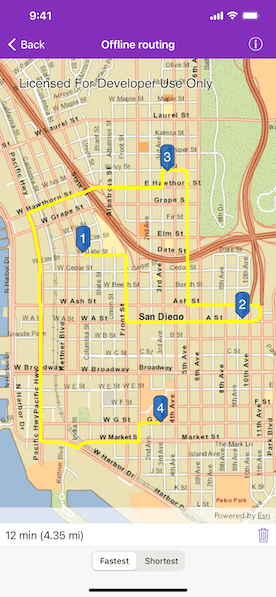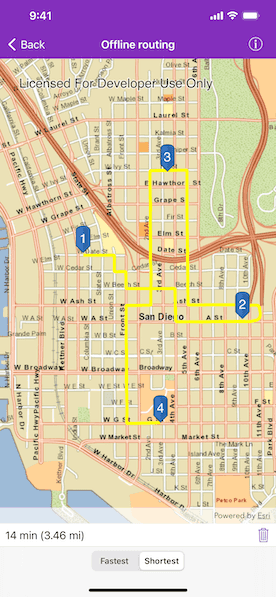Solve a route on-the-fly using offline data.


Use case
You can use an offline network to enable routing in disconnected scenarios. For example, you could provide offline location capabilities to field workers repairing critical infrastructure in a disaster when network availability is limited.
How to use the sample
Tap near a road to start adding a stop to the route, tap again to place it on the map. A number graphic will show its order in the route. After adding at least 2 stops, a route will display. Choose "Fastest" or "Shortest" to control how the route is optimized. The route will update on-the-fly while adding stops.
How it works
- Create the map's
AGSBasemapfrom a local tile package using anAGSTileCacheandAGSArcGISTiledLayer. - Create an
AGSRouteTaskwith an offline locator geodatabase. - Generate default
AGSRouteParametersusingAGSRouteTask.defaultRouteParameters(completion:). - Create an
ASGStopobject for each destination and assign the stops to the parameters usingAGSRouteParameters.setStops(_:). - Solve the route using
AGSRouteTask.solveRoute(with:completion:)to get anAGSRouteResult. - Create a graphic with the route's geometry and a
AGSSimpleLineSymboland display it on anotherAGSGraphicsOverlay.
Relevant API
- AGSRouteParameters
- AGSRouteResult
- AGSRouteTask
- AGSStop
- AGSTravelMode
Offline data
The data used by this sample is available on ArcGIS Online.
About the data
This sample uses a pre-packaged sample dataset consisting of a geodatabase with a San Diego road network and a tile package with a streets basemap.
Tags
connectivity, disconnected, fastest, locator, navigation, network analysis, offline, routing, shortest, turn-by-turn
Sample Code
// Copyright 2016 Esri.
//
// Licensed under the Apache License, Version 2.0 (the "License");
// you may not use this file except in compliance with the License.
// You may obtain a copy of the License at
//
// http://www.apache.org/licenses/LICENSE-2.0
//
// Unless required by applicable law or agreed to in writing, software
// distributed under the License is distributed on an "AS IS" BASIS,
// WITHOUT WARRANTIES OR CONDITIONS OF ANY KIND, either express or implied.
// See the License for the specific language governing permissions and
// limitations under the License.
import UIKit
import ArcGIS
class OfflineRoutingViewController: UIViewController, AGSGeoViewTouchDelegate {
@IBOutlet var mapView: AGSMapView!
@IBOutlet var segmentedControl: UISegmentedControl!
@IBOutlet var distanceLabel: UILabel!
@IBOutlet var timeLabel: UILabel!
@IBOutlet var detailsViewBottomContraint: NSLayoutConstraint!
var map: AGSMap!
var routeTask: AGSRouteTask!
var params: AGSRouteParameters!
private var stopGraphicsOverlay = AGSGraphicsOverlay()
private var routeGraphicsOverlay = AGSGraphicsOverlay()
private var longPressedGraphic: AGSGraphic!
private var longPressedRouteGraphic: AGSGraphic!
private var routeTaskOperation: AGSCancelable!
private var totalDistance: Double = 0 {
didSet {
let miles = String(format: "%.2f", totalDistance * 0.000621371)
self.distanceLabel?.text = "(\(miles) mi)"
}
}
private var totalTime: Double = 0 {
didSet {
var minutes = Int(totalTime)
let hours = minutes / 60
minutes = minutes % 60
let hoursString = hours == 0 ? "" : "\(hours) hr "
let minutesString = minutes == 0 ? "0 min" : "\(minutes) min"
self.timeLabel?.text = "\(hoursString)\(minutesString)"
}
}
override func viewDidLoad() {
super.viewDidLoad()
// add the source code button item to the right of navigation bar
(self.navigationItem.rightBarButtonItem as! SourceCodeBarButtonItem).filenames = ["OfflineRoutingViewController"]
// using a tpk to create a local tiled layer
// which will be visible in case of no network connection
let tileCache = AGSTileCache(name: "streetmap_SD")
let localTiledLayer = AGSArcGISTiledLayer(tileCache: tileCache)
// initialize the map using the local tiled layer as baselayer
self.map = AGSMap(basemap: AGSBasemap(baseLayer: localTiledLayer))
// assign the map to the map view
self.mapView.map = self.map
// register self as the touch delegate for the map view
// will be using the touch gestures to add the stops
self.mapView.touchDelegate = self
// add graphics overlay, one for the stop graphics
// and other for the route graphics
self.mapView.graphicsOverlays.addObjects(from: [self.routeGraphicsOverlay, self.stopGraphicsOverlay])
// get the path for the geodatabase in the bundle
let dbPath = Bundle.main.path(forResource: "sandiego", ofType: "geodatabase", inDirectory: "san-diego")!
// initialize the route task using the path and the network name
self.routeTask = AGSRouteTask(fileURLToDatabase: URL(fileURLWithPath: dbPath), networkName: "Streets_ND")
// get default route parameters
self.getDefaultParameters()
// zoom to San Diego
self.mapView.setViewpointCenter(AGSPoint(x: -13042254.715252, y: 3857970.236806, spatialReference: .webMercator()), scale: 2e4)
// enable magnifier for better experience while using tap n hold to add a stop
self.mapView.interactionOptions.isMagnifierEnabled = true
}
// method returns a graphic for the specified location
// also assigns the stop number
private func graphicForLocation(_ point: AGSPoint) -> AGSGraphic {
let symbol = self.symbolForStopGraphic(withIndex: self.stopGraphicsOverlay.graphics.count + 1)
let graphic = AGSGraphic(geometry: point, symbol: symbol, attributes: nil)
return graphic
}
private func symbolForStopGraphic(withIndex index: Int) -> AGSSymbol {
let markerImage = UIImage(named: "BlueMarker")!
let markerSymbol = AGSPictureMarkerSymbol(image: markerImage)
markerSymbol.offsetY = markerImage.size.height / 2
let textSymbol = AGSTextSymbol(text: "\(index)", color: .white, size: 20, horizontalAlignment: .center, verticalAlignment: .middle)
textSymbol.offsetY = markerSymbol.offsetY
let compositeSymbol = AGSCompositeSymbol(symbols: [markerSymbol, textSymbol])
return compositeSymbol
}
// MARK: - AGSGeoViewTouchDelegate
func geoView(_ geoView: AGSGeoView, didTapAtScreenPoint screenPoint: CGPoint, mapPoint: AGSPoint) {
// on single tap, add stop graphic at the tapped location
// and route
let graphic = self.graphicForLocation(mapPoint)
self.stopGraphicsOverlay.graphics.add(graphic)
// clear the route graphic
self.longPressedRouteGraphic = nil
self.route(isLongPressed: false)
}
func geoView(_ geoView: AGSGeoView, didLongPressAtScreenPoint screenPoint: CGPoint, mapPoint: AGSPoint) {
// add the graphic at that point
// keep a reference to that graphic to update the geometry if moved
let graphic = graphicForLocation(mapPoint)
self.stopGraphicsOverlay.graphics.add(graphic)
self.longPressedGraphic = graphic
// clear the route graphic
self.longPressedRouteGraphic = nil
// route
self.route(isLongPressed: true)
}
func geoView(_ geoView: AGSGeoView, didMoveLongPressToScreenPoint screenPoint: CGPoint, mapPoint: AGSPoint) {
// update the graphic
// route
self.longPressedGraphic.geometry = mapPoint
self.route(isLongPressed: true)
}
// MARK: - Route logic
private func getDefaultParameters() {
// get the default parameters
self.routeTask.defaultRouteParameters { [weak self] (params: AGSRouteParameters?, error: Error?) in
if let error = error {
print(error)
} else {
self?.params = params
}
}
}
func route(isLongPressed: Bool) {
// if either default parameters failed to generate or
// the number of stops is less than two, return
if self.params == nil {
print("Failed to generate default parameters")
return
}
if self.stopGraphicsOverlay.graphics.count < 2 {
print("The stop count is less than 2")
return
}
// cancel previous requests
self.routeTaskOperation?.cancel()
self.routeTaskOperation = nil
// get the geometries for the last two graphics in the overlay
let count = self.stopGraphicsOverlay.graphics.count
guard let geometry1 = (self.stopGraphicsOverlay.graphics[count - 2] as? AGSGraphic)?.geometry as? AGSPoint else {
print("Graphic's geometry is invalid")
return
}
guard let geometry2 = (self.stopGraphicsOverlay.graphics[count - 1] as? AGSGraphic)?.geometry as? AGSPoint else {
print("Graphic's geometry is invalid")
return
}
// create stops using the last two graphics in the overlay
let stop1 = AGSStop(point: (geometry1))
let stop2 = AGSStop(point: (geometry2))
let stops = [stop1, stop2]
// clear the previous stops
self.params.clearStops()
// add the new stops
self.params.setStops(stops)
// set the new travel mode
self.params.travelMode = self.routeTask.routeTaskInfo().travelModes[self.segmentedControl.selectedSegmentIndex]
self.route(with: self.params, isLongPressed: isLongPressed)
}
func route(with params: AGSRouteParameters, isLongPressed: Bool) {
// solve for route
self.routeTaskOperation = self.routeTask.solveRoute(with: params) { [weak self] (routeResult: AGSRouteResult?, error: Error?) in
if let error = error {
if (error as NSError).code != NSUserCancelledError {
print(error)
}
} else {
// handle the route result
self?.displayRoutesOnMap(routeResult?.routes, isLongPressedResult: isLongPressed)
}
}
}
func displayRoutesOnMap(_ routes: [AGSRoute]?, isLongPressedResult: Bool) {
// if a route graphic for previous request (in case of long press)
// exists then remove it
if let longPressedRouteGraphic = longPressedRouteGraphic {
// update distance and time
self.totalTime -= Double(truncating: self.longPressedGraphic.attributes["routeTime"] as! NSNumber)
self.totalDistance -= Double(truncating: self.longPressedGraphic.attributes["routeLength"] as! NSNumber)
self.routeGraphicsOverlay.graphics.remove(longPressedRouteGraphic)
self.longPressedRouteGraphic = nil
}
// if a route is returned, create a graphic for it
// and add to the route graphics overlay
if let route = routes?.first {
let routeGraphic = AGSGraphic(geometry: route.routeGeometry, symbol: self.routeSymbol(), attributes: nil)
// keep reference to the graphic in case of long press
// to remove in case of cancel or move
if isLongPressedResult {
self.longPressedRouteGraphic = routeGraphic
// set attributes (to subtract in case the route is not used)
self.longPressedGraphic.attributes["routeTime"] = route.totalTime
self.longPressedGraphic.attributes["routeLength"] = route.totalLength
}
self.routeGraphicsOverlay.graphics.add(routeGraphic)
// update total distance and total time
self.totalTime += route.totalTime
self.totalDistance += route.totalLength
self.setDetailsViewVisibility(visible: true)
}
}
// method returns the symbol for the route graphic
func routeSymbol() -> AGSSimpleLineSymbol {
let symbol = AGSSimpleLineSymbol(style: .solid, color: .yellow, width: 5)
return symbol
}
// MARK: - Actions
@IBAction func trashAction() {
// empty both graphic overlays
self.routeGraphicsOverlay.graphics.removeAllObjects()
self.stopGraphicsOverlay.graphics.removeAllObjects()
// reset distance and time
self.totalTime = 0
self.totalDistance = 0
// hide the details view
self.setDetailsViewVisibility(visible: false)
}
@IBAction func modeChanged(_ segmentedControl: UISegmentedControl) {
// re route for already added stops
if self.stopGraphicsOverlay.graphics.count > 1 {
var stops = [AGSStop]()
for graphic in self.stopGraphicsOverlay.graphics as AnyObject as! [AGSGraphic] {
let stop = AGSStop(point: graphic.geometry! as! AGSPoint)
stops.append(stop)
}
self.params.clearStops()
self.params.setStops(stops)
// set the new travel mode
self.params.travelMode = self.routeTask.routeTaskInfo().travelModes[self.segmentedControl.selectedSegmentIndex]
// clear all previous routes
self.routeGraphicsOverlay.graphics.removeAllObjects()
// reset distance and time
self.totalDistance = 0
self.totalTime = 0
// route
self.route(with: self.params, isLongPressed: false)
}
}
// MARK: toggle details view
private func setDetailsViewVisibility(visible: Bool) {
self.detailsViewBottomContraint.constant = visible ? 0 : -36
UIView.animate(withDuration: 0.3) { [weak self] in
self?.view.layoutIfNeeded()
}
}
}